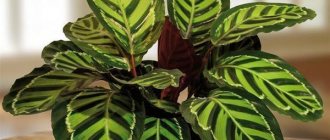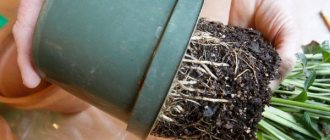Calathea is a perennial plant from the Marantaceae family, today there are more than 150 species, native to Africa and South America.
Loves high humidity and grows near rivers and streams.
Under natural conditions, the height exceeds several meters; the ornamental plant is usually 35-40 cm.
It has rightfully won the love of gardeners from different countries.
What is so attractive about this plant?
- 1 General information about the plant Calathea medallion
- 2 Calathea care
- 3 Creation of conditions
- 4 Lighting and temperature
- 5 Watering, feeding
- 6 Soil and replanting
- 7 Reproduction
- 8 Dividing the rhizome
- 9 Cuttings
- 10 Seeds
- 11 Possible care problems
- 12 Diseases
- 13 Pests
Photo
You can clearly see Calathea “Medallion” in the photo below:
Calathea rufibarba/velvet calathea (Calathea rufibarba)
This species is sometimes called the "redbeard" because of its orange fur. Calathea rufibarba reaches 50 cm in height. Dense, elongated leaves are located on long petioles. The leaf blades have wavy edges, pointed towards the top. The upper side of the leaf has a rich green color, without any patterns. The lower part, in turn, is burgundy.
The main distinguishing feature of this calathea is the pubescence located on the petioles and the underside of the leaves. These hairs have a light red tint.
In its natural environment, the plant blooms with small creamy spike-shaped inflorescences. In Calathea culture, Rufibarba practically does not bloom.
Home care
Let’s take a closer look at the rules for caring for Calathea “Medallion” at home.
Where is the best place to grow?
This variety of calathea is a delicate creature. Therefore, “Medallion” is recommended to be grown at home, in a warm, sunny room with a high level of air humidity.
It is not advisable to place a flower on a balcony or take it out into the garden in the fresh air in the summer.
Plant pruning
There is a lot of controversy about whether it is worth trimming a flower to form a more luxuriant crown or not.
REFERENCE! Calathea needs to be pruned only at the time of replanting. Otherwise, the flower may die!
When replanting from a plant, you need to cut off old and dried leaves; the roots should not be touched. Scissors (blades) that will be used for pruning must be disinfected in hydrogen peroxide.
Lighting
The plant needs sufficient lighting. The light should be soft, diffused . In summer, it is necessary to shade the flower and prevent direct sunlight from hitting it.
Sunburn damages delicate leaves, covering their surface with brown spots.
Lack of lighting can have a detrimental effect on the variegated color of the leaves - they become uniformly green and lose all their decorative effect.
In winter, Calathea "Medallion" needs additional artificial lighting.
Regular electric lamps are suitable for this, they will extend the daylight hours for the plant.
Calathea is best placed near a window facing east or west.
Temperature
This is a fairly heat-loving flower. The optimal temperature in summer is 20-24 degrees, in winter - 18-20 . It is necessary to avoid sudden changes in temperature and drafts, which Calathea cannot tolerate.
Watering
Excess and lack of watering is very harmful to the pampered beauty of Calathea. Therefore, moderation should be observed. In hot weather, watering is more abundant and is done as soon as the top layer of soil dries out. In winter - less often, about once a week.
To prevent stagnation of moisture in the pot, it is necessary to plant the flower in loose soil.
In hot weather, the plant should be irrigated frequently with warm, settled water.
REFERENCE! Like all plants of the arrowroot family, Calatheas are adherents of high air humidity. Therefore, in the summer, it is advisable to place a flowerpot with a flower on a tray with wet expanded clay drainage!
Planting and replanting
The key to healthy growth of Calathea “Medallion” and its abundant flowering is a well-chosen substrate.
Experienced flower growers recommend the following composition:
- leaf soil - 2 hours;
- sand - 1 hour;
- peat - 2 hours.
To make the soil more loose, you can add small pieces of charcoal to the soil.
A layer of expanded clay drainage is placed at the bottom of the pot.
Frequent replanting harms Calathea.
Adult plants are replanted every 2 years, young plants need annual soil replacement.
Replant the flower very carefully, trying not to damage the root system.
It is advisable to use the “transfer method” (the old earthen ball around the roots is not destroyed, but placed in a new flowerpot, the voids around are sprinkled with fresh substrate).
The pot should be proportionate to the root system. A container that is too large can cause the soil mixture to sour and the roots to rot.
The most suitable time for transplantation is late spring.
REFERENCE! The soil for replanting calathea must be free of lime! This must be taken into account when purchasing a ready-made mixture in a store.
Reproduction
Calathea can be propagated in 3 ways:
- By dividing the rhizome .
This method is usually used when replanting a plant. The rhizome is divided into several parts using a knife or by hand. It is necessary that each shoot has several leaves and roots. After division, each shoot is planted in light soil consisting of peat and sand (1:1). The pots are covered on top with a plastic bag or glass jar to create a greenhouse effect and placed in a warm place. Remove the coverings after the first leaves appear. - By cuttings .
The propagation method using stem cuttings is most often used. To do this, cuttings approximately 12-15 cm long with one node and several leaves are placed in a sand-peat mixture (1:1) and placed in a warm place, covered with polyethylene or a jar on top. The cut of the cuttings must be sprinkled with activated carbon to avoid rotting. The coverings are removed after the plant has rooted. - Seeds. Calathea can be propagated using seeds.
To do this, the seeds are placed on the surface of the soil, pressed down with glass and left for several weeks until germination.From time to time the glass is raised for ventilation. Germinated seeds are placed deeper into the soil (1 cm).
The emerging seedlings are planted separately in small pots.
This method is quite complicated, especially for beginner flower growers. Seeds do not always sprout, many seedlings are weak and die, so it is better to use the two previous methods of Calathea propagation.
Fertilizer
The plant needs feeding. Liquid fertilizer for deciduous and ornamental plants is suitable for this. Calathea is fertilized in the spring and summer once every 10-15 days, in winter no more than once a month.
Reproduction
The plant propagates by dividing the bush, cuttings and seeds. Each method has its own characteristics and difficulties.
Dividing rhizomes
You can divide the bush only during transplantation.
This must be done extremely carefully, since if you move incorrectly, you can easily damage the root and the plant will die:
- The root is cut with a knife so that each part has leaves and a strong root system.
- Each shoot is immersed in a separate pot filled with substrate and covered with a bag or a cut bottle.
- When young leaves appear, the cover can be removed.
Important! This propagation method is best used when absolutely necessary, as it can harm a sensitive plant.
Cuttings
This is the most effective and practical way to breed calathea:
- A petiole 15 cm long and with one (or more) internodes, or two or three leaves is cut from the mother bush.
- Its cut is treated with activated carbon powder, then it is immersed in a moist substrate for rooting.
- The top of the petiole is covered with a cut bottle.
- The container is sent to a warm, bright place until a fresh leaf appears.
Seeds
For this method, select a shallow container filled with a substrate with a drainage layer:
- The collected seeds are laid out on the surface of the soil.
- The seeds are sprinkled with earth on top.
- The container is covered with film and sent to a warm place.
- Every day, the soil moisture in the greenhouse is checked and airing is performed for half an hour.
- When the seedlings become 3-4 cm high, they are planted in individual pots.
Did you know? The second name of all flowers from the genus Calathea is
"
prayer
plant " It turned out because their leaves can take either a vertical or a horizontal position.
Diseases
The appearance of brown spots on the leaves
This usually happens for two reasons: sunburn and waterlogging of the soil. It is advisable to shade the calathea and change the watering regime.
Leaves dry and curl
Drought, insufficient watering, low air humidity . You should spray the plant more often with warm and settled water, since cold and hard water can also cause dry edges on the leaf blade.
Dried leaves must be removed from the flower. Dry edges also need to be trimmed, very carefully so as not to harm the living part of the leaf.
If the flower is completely dry, do not rush to throw it away, remove the roots from the pot and inspect them.
If the roots are fresh and healthy, transplant them into a new container, water the soil and after a while new shoots will appear.
Dried and curled leaves also indicate thrips infestation..
You need to carefully examine the inside of the sheet. If a parasite is detected, treat the plant with any insecticidal solution.
The leaves are turning yellow
The light in the room is too bright or the plant suffers from drafts. Place Calathea deep in the room and observe its behavior.
Description of the plant
Calathea belongs to the arrowroot family and is a rhizomatous plant. Large oval-shaped leaves emerge immediately from the root and are compactly arranged in several tiers.
A beautiful pattern is formed due to white patterns that follow the contour near the edge, and yellowish veins in the center.
On the underside, the leaves have a purple tint, turning upward in the evening , and in the morning dropping back to a horizontal position.
Flowering is not expressed by pale yellow flowers , the value of which is only in the possible formation of seeds.
Pests
Most often, Calathea “Medallion” is susceptible to attack by spider mites and thrips. The appearance of these harmful insects provokes excessively dry air in the room. Signs of damage can be seen with the naked eye:
- Spider mite - a large amount of thin white cobwebs appear on the leaves, the plant withers and withers, its leaves fall off;
- Thrips - usually lives on the inner surface of leaf blades, eating them away from the inside. First, a light spot appears on the surface of the leaf, over time it changes color, dries, crumbles, forming a hole.
Method of combating parasites : wipe the leaves of the plant with a soap solution (water, laundry soap), then treat with any insecticide. After treatment, the flower needs to be fed (after 5-6 days).
Caring for the capricious Calathea is not easy, but all your efforts will pay off when this incredibly beautiful tropical plant blooms in your apartment.
Calathea bachemiana
Currently, this type is one of the most popular. Its natural habitat is the tropical forests of Brazil. Calathea Bachema is distinguished by its unpretentiousness when compared with other representatives of the genus. In addition, it has quite bright decorative features.
It has lanceolate leaves, without a petiole. Reaches 35 cm in height. The width of the leaves is about 7-8 cm, and the length is 15-20 cm. Towards the top they narrow sharply. They have a dense leathery structure. The upper side of the leaf blade is light green, with a bright silvery tint. There is a dark green border along the edge of the plate. The underside is somewhat darker and monochromatic. A characteristic feature of the species is a pattern of dark spots or stripes running along the central vein.
Cream flowers are located on short pedicels, the length of which does not exceed 2.5 cm, and are collected in small, about 6 cm in length, spike-shaped inflorescences. After flowering, the plant often loses the entire above-ground part, but after a while new shoots appear. But in indoor conditions, Calathea Bachema practically does not bloom.
Habitats and where you can buy it
In the wild, Calathea grows near rivers and lakes in Central and South America (most are native to Brazil, some - Ecuador, for example - Red Tiger).
Of course, in our climatic conditions they are not very actively distributed. You can even purchase Calathea only in a specially equipped store. Otherwise, you should be very attentive to the condition of the leaves of the flower. If they are slightly dry around the edges, the plant may not be healthy. On the other hand, perhaps it simply does not have enough humidity, so if good conditions are provided, the beauty will come to life and become healthy.
Calathea Lietzei
The plant reaches no more than 60 cm in height. The leaves are about 15 cm long and 6-8 cm wide. The edges are wavy. The upper side of the leaf plate is green with a bright glossy sheen. It has wide dark green and silver stripes with torn edges. The leaves are pale red below.
Calathea Litze is relatively easy to maintain. The flowers are small, white or light cream in color. Unlike other calathas, representatives of this species form dense bushes under favorable conditions.
Decorative qualities
Almost all Calatheas bloom, but Calathea Crocata (aka Saffron - named after the flower for a reason, anyway) blooms especially brightly. True, it blooms in winter and subject to daily ten-hour daylight, but its flowers are large and orange-reddish in color. Its leaves are not particularly remarkable and have the usual oblong shape and are monochromatic - dark green. This “boringness” is compensated by the presence of the largest flowers among Calathea. If you are looking for a compromise so that both the leaves and flowers are beautiful, you should pay attention to Calathea Varshevich. Its flowers can be pink, white or cream-colored, and the leaves have a dark shade with light veins. On the reverse side they have a dull burgundy color. In spring, the shoots of Calathea Varshevich should be planted. If it is not replanted once every two years, then it must be replanted every year.
Possible problems
Some species, at the slightest discrepancy between their living conditions and their requirements, begin to “rebel” - their leaves begin to dry out, turn yellow and curl. A dissatisfied Calathea will not bloom, so if it begins to bloom, you can rejoice, because this means that you managed to satisfy all its requirements, you love your flower very much and it loves you very much in return - so it thanks you in the best way it can.
How to care for autumn and winter?
With the onset of cold weather, the calathea prepares for sleep. Its metabolic process is significantly reduced, so the amount of fertilizer applied is reduced. But Calathea Saffron, which begins to bloom during this period, must continue to be fed according to the usual scheme.
The liquid content in the pot in the autumn-winter period is also important. Water the flower only when the soil is one third dry. If the room temperature is not high, watering is done when the soil is half dry. It must be remembered that a tropical plant does not require a strong drop in temperature for wintering, otherwise it will freeze.
Summarize
These are the most famous species of the genus Calathea. If you like the pattern on the leaves of a flower, but there is no opportunity or desire to maintain the conditions necessary for its life, try to look for a similar pattern among other Maranthaceae - as a rule, many Calathea have doubles among them. And at the same time, they are more durable - and the requirements, for example, of the same Maranta, are almost half as much.
Related posts:
- Beautiful Calathea with variegated leaves and a complex character. Even a quick glance at this flower is enough to fall in love with it. Contents1 Description2 In the interior3 Structural features4 Useful properties5…
- Transplantation and propagation of the “Eastern beauty” Calathea Correctly and timely transplantation is the key to the health of any plant. But first things first. Contents1 Soil renewal1.1 Frequency1.2 Before performing...
- We consider Calathea Diseases and fight possible pests. This capricious plant, which requires special attention, is especially susceptible to various misfortunes. Contents1 Health status1.1 How to determine the condition of a flower1.2 Checking...
- What can Calathea bring to the house, what does it symbolize and what is its significance? The brighter and more unusual a plant looks, the more superstitions it is endowed with... Contents1 Interaction with the energy of the house2 Selecting the appropriate flora...
Calathea burle-marxii/Ice Blue Calathea
This type of calathea is native to Brazil. The height of the plant does not exceed 60 cm. The leaves are obovate, wide. The upper side of the leaf blade is light green, with a noticeable blue tint. The pattern consists of symmetrical dark stripes of different sizes. The lower part of the leaf has a purple tint.
Calathea of this species stands out among others due to the unusual color of its flowers. They are white, sometimes slightly pinkish in color. However, the flowers also have an admixture of blue or light blue, which is unusual for other representatives of the genus. It is thanks to the delicate bluish tint that the flowers resemble frozen ice. Sometimes there are plants that have pure white flowers.
Reviews from flower growers
It is very capricious to humidity, it is very difficult to create a certain atmosphere for it, I have a fountain in a small house, so I placed it as close as possible to the fountain and also spray it almost 3-4 times a day, otherwise it begins to fold its leaves.
ENat https://forum.bestflowers.ru/t/kalateja-calathea.1023/
My calathea lived for six months without problems, producing leaf after leaf. The ends dried out a little, but I sprayed it three times a day. Then I started feeling bad. I once went into a store, complained about my calathea, and they offered, as an exception, to help me bring it back to life. They transplanted it for me, planted it in some cool soil, and treated it for pests. And now my calathea comes back to life! Already the fourth new leaf is growing.
Lyudmilochka https://cvetoforum.ru/topic965–15.html
A few words about watering - it should be regular. Do not flood, of course, we are waiting for the top layer of soil to dry out. Water for irrigation must be settled or filtered. And for any plant. Any sunny side will do, just keep in mind that calathea is sun-loving, but direct sunlight will cause burns on the leaves.
Vasilisa https://greenforum.com.ua/showthread.php?t=3651
Despite the fact that calathea is quite capricious and whimsical, it is very popular among gardeners. After all, its unusually beautiful leaves are a real decoration for any interior. If you are ready to create a humid microclimate for this sissy and devote a little time to her every day, she will fully thank you with her bright tropical beauty.
- Author: Oksana Kirichek
Hello! I'm Oksana. I am a financier by education and profession, and a copywriter by vocation. Creating articles is a very exciting and useful hobby for me. Rate this article:
- 5
- 4
- 3
- 2
- 1
(1 vote, average: 5 out of 5)
Share with your friends!











